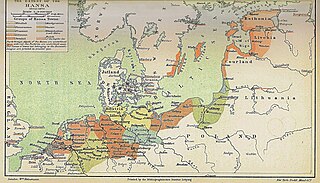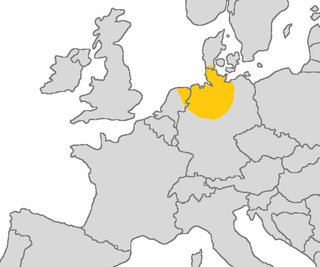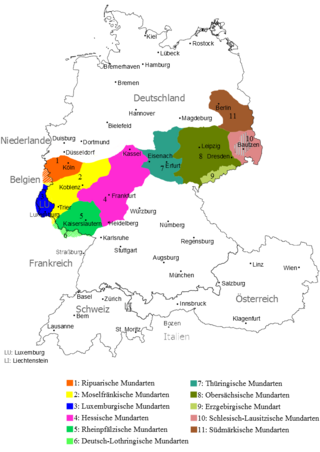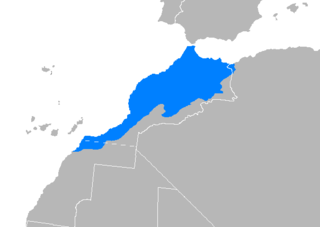Plautdietsch or Mennonite Low German is a Low Prussian dialect of East Low German with Dutch influence that developed in the 16th and 17th centuries in the Vistula delta area of Royal Prussia. The word Plautdietsch translates to "flat German". In other Low German dialects, the word for Low German is usually realised as Plattdütsch/Plattdüütsch or Plattdüütsk, but the spelling Plautdietsch is used to refer specifically to the Vistula variant of the language.

Northern Bavarian is a dialect of Bavarian, together with Central Bavarian and Southern Bavarian. Bavarian is mostly spoken in the Upper Palatinate, although not in Regensburg, which is a primarily Central Bavarian–speaking area, according to a linguistic survey done in the late 1980s. According to the same survey, Northern Bavarian is also spoken in Upper Franconia, as well as in some areas in Upper and Lower Bavaria, such as in the areas around Eichstätt and Kelheim. Few speakers remained in the Czech Republic, mostly concentrated around Aš and Železná Ruda, at the time of the survey, but considering the time which has passed since the survey, the dialect may be extinct in those places today. If it still exists there, it would include the ostegerländische Dialektgruppe. Ethnologue estimates that there were 9,000 speakers of Bavarian in the Czech Republic in 2005, but does not clarify if these were Northern Bavarian speakers.
Middle Dutch is a collective name for a number of closely related West Germanic dialects whose ancestor was Old Dutch. It was spoken and written between 1150 and 1500. Until the advent of Modern Dutch after 1500 or c. 1550, there was no overarching standard language, but all dialects were mutually intelligible. During that period, a rich Medieval Dutch literature developed, which had not yet existed during Old Dutch. The various literary works of the time are often very readable for speakers of Modern Dutch since Dutch is a rather conservative language.
Middle High German is the term for the form of German spoken in the High Middle Ages. It is conventionally dated between 1050 and 1350, developing from Old High German and into Early New High German. High German is defined as those varieties of German which were affected by the Second Sound Shift; the Middle Low German and Middle Dutch languages spoken to the North and North West, which did not participate in this sound change, are not part of MHG.

Middle Low German is a developmental stage of Low German. It developed from the Old Saxon language in the Middle Ages and has been documented in writing since about 1225/34 (Sachsenspiegel). During the Hanseatic period, Middle Low German was the leading written language in the north of Central Europe and served as a lingua franca in the northern half of Europe. It was used parallel to medieval Latin also for purposes of diplomacy and for deeds.

Old Saxon, also known as Old Low German, was a Germanic language and the earliest recorded form of Low German. It is a West Germanic language, closely related to the Anglo-Frisian languages. It is documented from the 8th century until the 12th century, when it gradually evolved into Middle Low German. It was spoken throughout modern northwestern Germany, primarily in the coastal regions and in the eastern Netherlands by Saxons, a Germanic tribe that inhabited the region of Saxony. It partially shares Anglo-Frisian's Ingvaeonic nasal spirant law which sets it apart from Low Franconian and Irminonic languages, such as Dutch, Luxembourgish and German.
Neo-Mandaic, also known as Modern Mandaic, sometimes called the "ratna", is the modern reflex of the Mandaic language, the liturgical language of the Mandaean religious community of Iraq and Iran. Although severely endangered, it survives today as the first language of a small number of Mandaeans in Iran and in the Mandaean diaspora. All Neo-Mandaic speakers are multilingual in the languages of their neighbors, Arabic and Persian, and the influence of these languages upon the grammar of Neo-Mandaic is considerable, particularly in the lexicon and the morphology of the noun. Nevertheless, Neo-Mandaic is more conservative even in these regards than most other Neo-Aramaic languages.

Northern or North Sámi is the most widely spoken of all Sámi languages. The area where Northern Sámi is spoken covers the northern parts of Norway, Sweden and Finland. The number of Northern Sámi speakers is estimated to be somewhere between 15,000 and 25,000. About 2,000 of these live in Finland and between 5,000 and 6,000 in Sweden, with the remaining portions being in Norway.
Mercian was a dialect spoken in the Anglian kingdom of Mercia. Together with Northumbrian, it was one of the two Anglian dialects. The other two dialects of Old English were Kentish and West Saxon. Each of those dialects was associated with an independent kingdom on the island. Of these, all of Northumbria and most of Mercia were overrun by the Vikings during the 9th century. Part of Mercia and all of Kent were successfully defended but were then integrated into the Kingdom of Wessex. Because of the centralisation of power and the Viking invasions, there is little to no salvaged written evidence for the development of non-Wessex dialects after Alfred the Great's unification, until the Middle English period.

East Flemish is a collective term for the two easternmost subdivisions of the so-called Flemish dialects, native to the southwest of the Dutch language area, which also include West Flemish. Their position between West Flemish and Brabantian has caused East Flemish dialects to be grouped with the latter as well. They are spoken mainly in the province of East Flanders and a narrow strip in the southeast of West Flanders in Belgium and eastern Zeelandic Flanders in the Netherlands. Even though the dialects of the Dender area are often discussed together with the East Flemish dialects because of their location, the latter are actually South Brabantian.

Hessian is a West Central German group of dialects of the German language in the central German state of Hesse. The dialect most similar to Hessian is Palatinate German of the Rhine Franconian sub-family. However, the Hessian dialects have some features which set them somewhat apart from other West-Central German dialects.
Bernese German, like other High Alemannic varieties, has a two-way contrast in plosives and fricatives that is not based on voicing, but on length. The absence of voice in plosives and fricatives is typical for all High German varieties, but many of them have no two-way contrast due to general lenition.
The phonology of the Persian language varies between regional dialects, standard varieties, and even from older variates of Persian. Persian is a pluricentric language and countries that have Persian as an official language have separate standard varieties, namely: Standard Dari (Afghanistan), Standard Iranian Persian and Standard Tajik (Tajikistan). The most significant differences between standard varieties of Persian are their vowel systems. Standard varieties of Persian have anywhere from 6 to 8 vowel distinctions, and similar vowels may be pronounced differently between standards. However, there are not many notable differences when comparing consonants, as all standard varieties a similar amount of consonant sounds. Though, colloquial varieties generally have more differences than their standard counterparts. Most dialects feature contrastive stress and syllable-final consonant clusters.
Old English phonology is necessarily somewhat speculative since Old English is preserved only as a written language. Nevertheless, there is a very large corpus of the language, and the orthography apparently indicates phonological alternations quite faithfully, so it is not difficult to draw certain conclusions about the nature of Old English phonology.
Dutch phonology is similar to that of other West Germanic languages, especially Afrikaans and West Frisian.

Hejazi Arabic or Hijazi Arabic (HA), also known as West Arabian Arabic, is a variety of Arabic spoken in the Hejaz region in Saudi Arabia. Strictly speaking, there are two main groups of dialects spoken in the Hejaz region, one by the urban population, originally spoken mainly in the cities of Jeddah, Mecca, Medina and partially in Ta'if and another dialect by the urbanized rural and bedouin populations. However, the term most often applies to the urban variety which is discussed in this article.
Bulgarian conjugation is the creation of derived forms of a Bulgarian verb from its principal parts by inflection. It is affected by person, number, gender, tense, mood and voice. Bulgarian verbs are conventionally divided into three conjugations according to the thematic vowel they use in the present tense:

Erzgebirgisch is a (East) Central German dialect, spoken mainly in the central Ore Mountains in Saxony. It has received relatively little academic attention. Due to the high mobility of the population and the resulting contact with Upper Saxon, the high emigration rate and its low mutual intelligibility with other dialects, the number of speakers is decreasing.
Lithuanian has eleven vowels and 45 consonants, including 22 pairs of consonants distinguished by the presence or absence of palatalization. Most vowels come in pairs which are differentiated through length and degree of centralization.

Moroccan Arabic, also known as Darija, is the dialectal, vernacular form or forms of Arabic spoken in Morocco. It is part of the Maghrebi Arabic dialect continuum and as such is mutually intelligible to some extent with Algerian Arabic and to a lesser extent with Tunisian Arabic. It is spoken by 90.9% of the population of Morocco. While Modern Standard Arabic is used to varying degrees in formal situations such as religious sermons, books, newspapers, government communications, news broadcasts and political talk shows, Moroccan Arabic is the predominant spoken language of the country and has a strong presence in Moroccan television entertainment, cinema and commercial advertising. Moroccan Arabic has many regional dialects and accents as well, with its mainstream dialect being the one used in Casablanca, Rabat, Tangier, Marrakesh and Fez, and therefore it dominates the media and eclipses most of the other regional accents.








